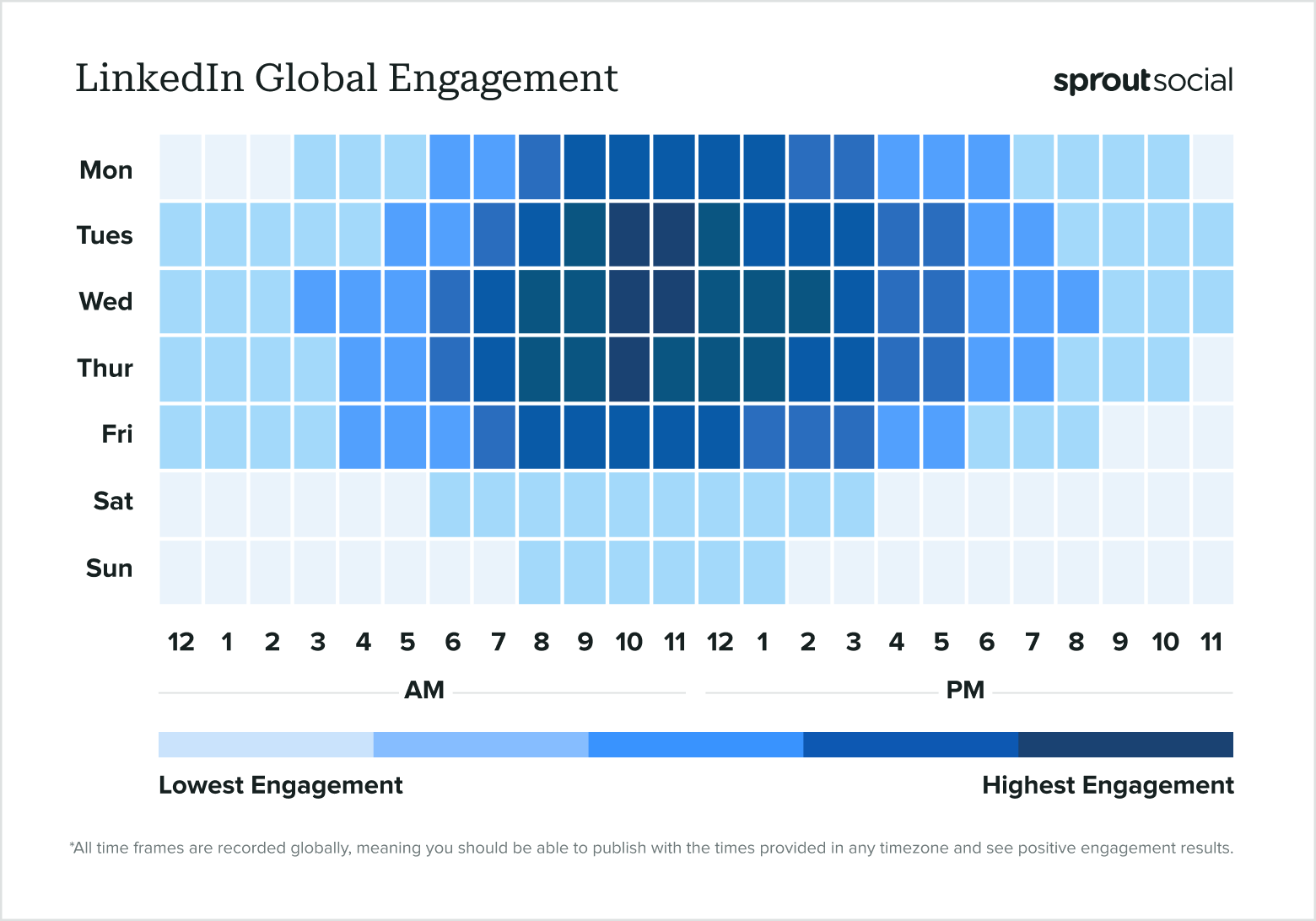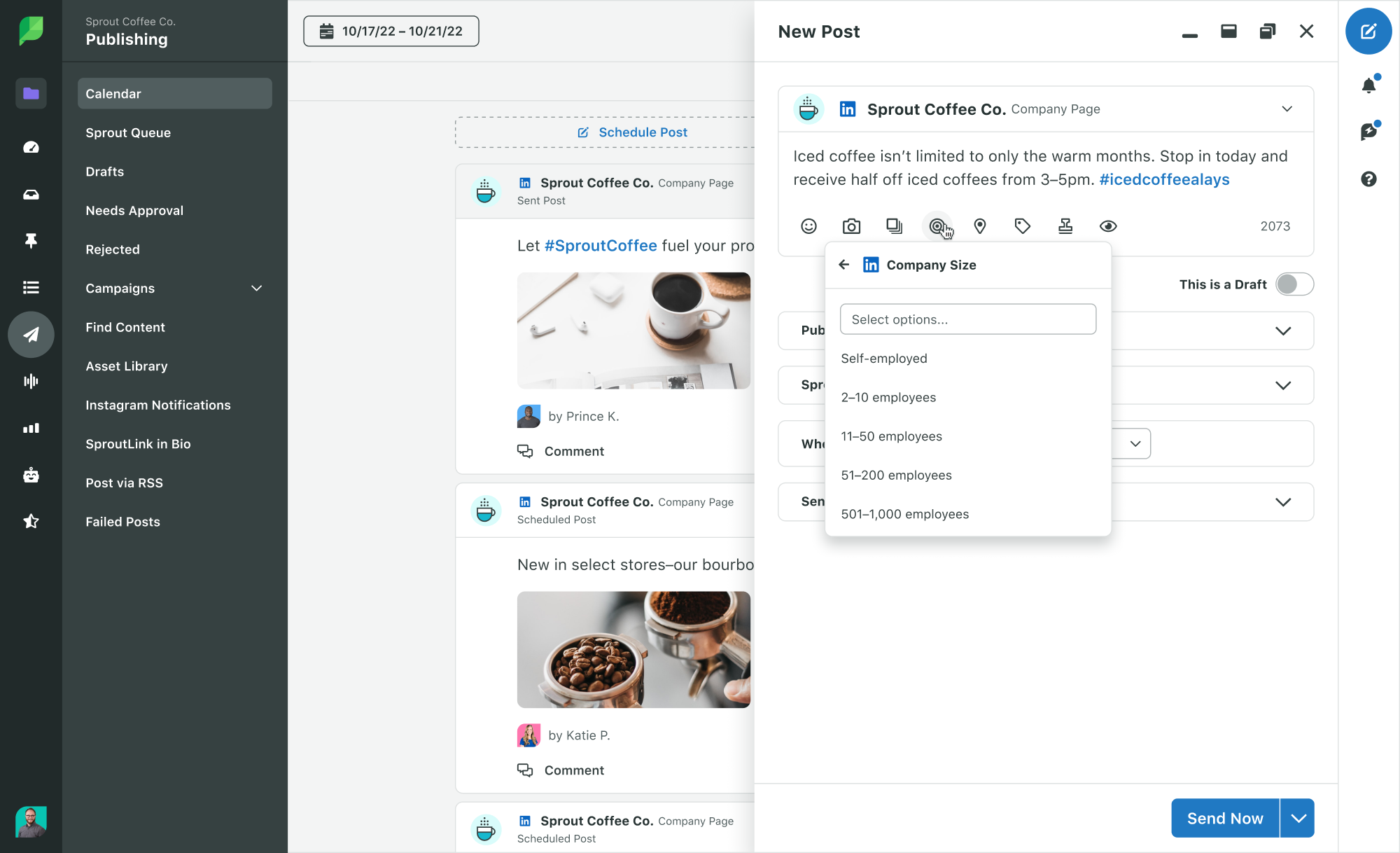Mastering LinkedIn content marketing: Strategies and examples

Table of Contents
B2B brands can’t afford to put off their LinkedIn content marketing strategy.
Because there’s no better place on social media to position yourself as a leader in your industry.
From networking and recruiting to building credibility and beyond, the value of LinkedIn marketing is clear. That said, creating a content strategy on LinkedIn is a different ballgame from Instagram or TikTok.
Want to engage your audience and translate your presence into business impact? You need to mind how you approach the platform. This post explains how to build a LinkedIn content marketing strategy from scratch.
Why do content marketing on LinkedIn?
Having a LinkedIn presence is an expectation for B2B brands.
However, no business should hop on a social platform “just because.”
Let’s explore the benefits and value of Linked content marketing, including why it’s worthwhile.
Sharing the latest industry trends
Breaking news. Industry legislation and regulations. The list goes on.
Sharing industry trends is a cornerstone of LinkedIn content marketing for good reason. Doing so shows that you’re an active participant in your industry. Likewise, being active on the platform helps you stay informed and keep a pulse on opportunities to educate your target audience.
Check out how Tastewise shares an industry report that positions the company as being in the know.

Sharing these sorts of insights serves to both educate and entertain your audience while also building your credibility.
Reaching a targeted audience
LinkedIn lets brands get seriously granular and niche down when it comes to audience targeting.
For example, want your brand to get in front of C-suite SaaS executives? Or entry-level employees in the manufacturing industry? You totally can!
Unlike other social networks where suit-and-tie content might seem “boring,” LinkedIn content marketing is all about doing business. The platform is a goldmine for reaching specific roles in specific industries.
Building brand credibility and thought leadership
Consistent, high-quality content on LinkedIn is crucial for establishing trust.
And this applies to both your business itself and your team.
Beyond trends, consider how you can share content related to your company’s values, accomplishments and opinions.
Done right, you can use LinkedIn to build the public profile of your company. This is especially true for your leadership and C-level employees. For even more targeted content delivery, consider utilizing LinkedIn showcase pages, which allow you to highlight specific aspects of your business, such as products or services, to segmented audiences.
Networking
LinkedIn content marketing isn’t just about talking up yourself. It’s also an opportunity to build business relationships and grow your team.
Consider that recruiting and vetting employees via LinkedIn has become standard for brands. You also don’t have to look hard to find brands networking and promoting their presence at events on the platform.
Posts from conferences like this one from Sprout Social are popular for the sake of shouting out business partners and encouraging face-to-face interactions.

Frequently publishing this sort of content and recruiting on LinkedIn also highlights your company’s growth and stability. All of the above is great news for positioning yourself as a leader.
Lead generation
Food for thought: nearly one-fourth of all B2B digital advertising happens on Linkedin.
The platform is a prime place to connect with B2B customers as they research your company, plus your achievements and accomplishments. Through organic content and ads, generating leads on LinkedIn can become a long-term, consistent channel for your brand.
And this brings together all of the other benefits of doing content marketing on LinkedIn.
The more you establish yourself, the more credible you look and the easier it is to win new targeted customers.
Crafting your LinkedIn content strategy in 5 steps
Like any networking, building a content strategy from the ground up can be daunting. Here’s a rundown of must-do steps to get your strategy up and running without getting totally overwhelmed.
1. Define your goals and objectives
So, why are you planning to post on LinkedIn in the first place?
This isn’t a trick question. After all, establishing a presence on any social network is a serious investment of time and resources. LinkedIn is no exception.
As a result, you need to be clear about your goals and KPIs. Here are some sample objectives to consider based on what you plan to prioritize:
- For thought leadership, try to hit a consistent post count from your brand and employee pages
- For awareness with your target audience, watch your LinkedIn analytics for reach and interactions
- For lead generation, look at interactions, site traffic from LinkedIn and engagement with ads
- For networking, look at views on your job postings, interactions and tags from other accounts and general engagement on the platform
No matter what your goals are, you need to track your progress and growth based on data. That way you can tie your LinkedIn content marketing efforts back to business results.
2. Identify your target audience
We really can’t stress it enough: LinkedIn is a B2B platform.
Especially if you have a B2C audience, you shouldn’t go to the platform promoting coupons and deals for your products. You need to consider who’s active on LinkedIn in your industry and who should ideally be engaging with your content.
Again, is your audience C-suite or entry-level employees? Do you plan on recruiting? Understand the roles you’re going after and craft content that speaks to those individuals.
This is where your LinkedIn analytics and tools like Sprout Social can really help. Check out Sprout Social’s analytics highlighting how you can analyze your LinkedIn audience based on industry and job title. These data points can inspire your content strategy and inform whether your posts are landing.

3. Plan your content pillars, topics and types
Breaking your LinkedIn content strategy into pillars and core topics not only keeps your presence more focused but also you stay organized as well. With your goals and target audience in mind, you can zero in on what you should be posting for engagement.
For example, your bigger content pillars might be:
- Company milestones, wins and product announcements
- Industry news and updates
- Behind-the-scenes content, including employee shout-outs and culture-centric content
- Thought leadership from your C-suite
Then you can establish the foundation of those pillars by exploring a variety of content formats, including:
- Text posts with strong visuals
- Articles and long-form content
- Images and infographics
- Videos (native uploads, live streams)
- LinkedIn Stories
- Polls and questions
Brands are spoiled for choice when it comes to LinkedIn post ideas. It’s all a matter of determining what your bandwidth is and what your target audience is most likely to engage with.
Still curious on how to expand your LinkedIn and cross-network content strategy? Our 2024 Social Media Content Strategy Report uncovers what content pillars and content types are successful on each network , including brand examples.
4. Create your content calendar and publishing schedule
With your pillars and formats locked down, you can determine your actual content calendar.
For example, how often do you plan to post and when? Based on Sprout’s own research, “optimal” posting on LinkedIn can be daily or near-daily on weekdays between 10:00 am and noon.

Consider your content pillars when mapping out your calendar so that each one gets an appropriate amount of posts. LinkedIn scheduling tools like Sprout Social make it easier to visualize your content calendar so you’re hitting on all the right themes are formats.

5. Promote, share and track content
LinkedIn can be frustrating to grow, especially for a totally new company. Growth comes from consistency and also getting your employees involved with promoting and cross-posting your content where appropriate.
Coupled with LinkedIn analytics, you can understand over time what’s working and what’s not so you can prioritize the formats that drive the most engagement. You might learn that polls or employee-centric posts are what’s growing your account above reposting articles or memes. You won’t know until you track your content.
Best practices for LinkedIn content marketing
To wrap things up, let’s review some LinkedIn content marketing best practices and some examples of brands nailing strategies.
Write compelling headlines and captions
Flexing your copywriting skills is a smart move on LinkedIn where hooks are all the rage.
Figma frequently uses hooks to open their posts and gets strong engagement and positive interactions from their followers as a result.

Remember: just because LinkedIn is a “business” platform doesn’t mean you need to be stuffy or boring.
Get creative with your headlines and captions for posts and don’t just drop links or resources without context. If you get writer’s block, you can always bounce ideas and hooks off of an AI social writing tool like Sprout.
Use strong visuals
Like other networks, the LinkedIn algorithm wants to keep users on the platform as much as possible. That’s why posting visuals like photos and videos is ideal for engagement versus just dropping links. Optimizing these visuals means understanding the most effective LinkedIn video formats for different content types, which can significantly boost viewer retention and interaction on the platform.
This graphic and video from Donut highlight how brands can grab the attention of users with strong visuals.

Meanwhile, this post from DocuSign turns a customer quote into a graphic. This is a great example of repurposing content on social media.

Photos, infographics, repurposed quotes and videos are just a taste of what you can post. Not only for engagement but also for establishing your brand’s identity with your content strategy on LinkedIn.
Include relevant calls to action
Again, don’t just drop random content on LinkedIn and expect engagement or interactions. To achieve your desired outcomes, it’s essential to follow LinkedIn best practices, including being specific about your intentions, which means pointing people to take specific actions.
Want them to read a blog post? Download a report? Watch a video? Be clear about it!
Check out how LUMA Partners shares an industry report while using LinkedIn’s native slideshow format.

Many brands also take advantage of dropping links in the first comments of a post rather than the post itself to avoid getting deprioritized by the LinkedIn algorithm. Just a tip!
Engage with comments and encourage discussions
LinkedIn is a social network. Any opportunities to go back and forth via discussions with your audience and industry are a plus.
Question-based posts should 100% be part of your strategy, as should polls. Picking your audience’s brain like Noir does can not only provide awesome insights but inspire future content ideas.

Just make a conscious effort to reply and engage with people who do respond to your content for the sake of getting more visibility with the LinkedIn algorithm.
Use relevant hashtags
Hashtags can serve as a way to get more visibility for your posts. Likewise, tags can help the LinkedIn algorithm better understand what your content is and serve it to users accordingly. If nothing else, hashtags can really help with LinkedIn SEO.
Hashtags on LinkedIn can be weaved into posts or tacked on at the end like Sparktoro does here.

Keep in mind that not every post necessarily needs hashtags. When in doubt, up to three seems to be the sweet spot for most brands.
Mention and tag other users or businesses strategically
One of the easiest ways to drive interactions on LinkedIn is to tag employees and other businesses when appropriate.
This can be done naturally when showing off your team, announcing a partnership or tagging earned media that you’re featured in. Note how Klaviyo tags brands in their post promoting customer case studies.

The caveat here is to not tag too aggressively or risk spamming other accounts. Much like with hashtags, not every post necessarily needs a @tag. Use your best judgment!
Encourage employees to share content
LinkedIn is one of the biggest platforms for employee advocacy. Content from people almost always outperforms content from brand accounts regardless of follower count or account size.
It’s important to rally your team to share and re-post your content, especially announcements and accomplishments. The team at Sprout Social does this all the time.

Ideally, your employees can put their own personal spin on posts to make them feel less one-size-fits-all. The bigger your team, the more valuable an employee advocacy platform (like Sprout!) can help you repost regularly and get your entire team involved in building your LinkedIn presence.
Ready to build your LinkedIn content marketing strategy?
Nailing your LinkedIn presence starts with your content strategy. Regardless of your goals, the right types of posts and publishing frequency can help you engage your target audience. The key is understanding your performance and sticking to a schedule.
Need inspiration to build up your brand’s account? Check out our LinkedIn for business worksheet to brainstorm ideas that can get you on the path to growth! Ready to try Sprout Social first-hand with your LinkedIn strategy? Sign up for a free 30-day trial and put that strategy to the test.

Share